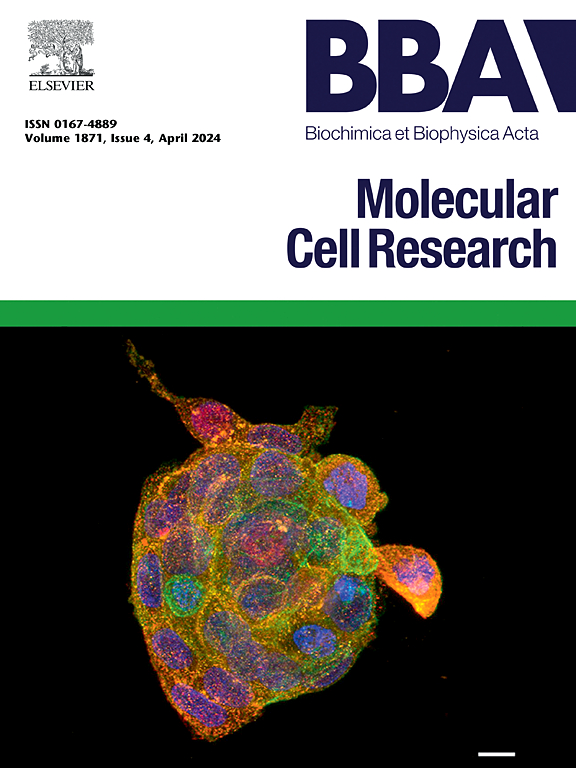TXNIP promotes ferroptosis through NCOA4 mediated ferritinophagy
IF 3.7
2区 生物学
Q1 BIOCHEMISTRY & MOLECULAR BIOLOGY
Biochimica et biophysica acta. Molecular cell research
Pub Date : 2025-09-04
DOI:10.1016/j.bbamcr.2025.120054
引用次数: 0
Abstract
Ferroptosis is a recently discovered lytic form of cell death that is triggered by iron-driven excessive lipid peroxidation and depletion of glutathione and glutathione peroxidase-4 (GPX4). This form of cell death has been linked to a wide range of conditions from cancer to neurodegenerative diseases. Using murine hippocampal HT22 neurons, we aimed to investigate the underlying mechanisms of glutamate-mediated ferroptosis. A robust increase in Thioredoxin-Inhibiting Protein (TXNIP) prompted us to use genetic approaches and examine the role of this protein in ferroptosis in HT22 neurons, mouse embryonic fibroblasts, and Hela cells. Our results indicate that TXNIP is a key player in ferroptotic pathway, as its deletion conferred resistance to classic ferroptosis-inducing agents (erastin, RSL3, and ML210), while TXNIP overexpression increased their susceptibility to ferroptosis. Notably, TXNIP deletion protected cells from mitochondrial dysfunction induced by ferroptotic agents, independent of GSH and GPX4 levels. We further showed that TXNIP mediates ferroptosis through facilitating degradation of the iron-binding protein ferritin via NCOA4-mediated ferritinophagy. This resulted in elevated cytosolic labile iron levels, therefore amplifying lipid peroxidation, and promoting ferroptosis. Our findings suggest that TXNIP acts as a positive regulator of ferroptosis by modulating autophagy and iron availability. Targeting TXNIP might hold promise in developing drugs for diseases involving the ferroptotic pathway.
TXNIP通过NCOA4介导的铁蛋白自噬促进铁凋亡。
Ferroptosis是最近发现的一种细胞死亡的溶解形式,由铁驱动的过度脂质过氧化和谷胱甘肽和谷胱甘肽过氧化物酶-4 (GPX4)的消耗引发。这种形式的细胞死亡与从癌症到神经退行性疾病的广泛疾病有关。利用小鼠海马HT22神经元,我们旨在探讨谷氨酸介导的铁下垂的潜在机制。硫氧还蛋白抑制蛋白(TXNIP)的显著增加促使我们使用遗传方法并检测该蛋白在HT22神经元、小鼠胚胎成纤维细胞和Hela细胞中铁凋亡中的作用。我们的研究结果表明,TXNIP是铁凋亡途径的关键参与者,因为它的缺失使其对经典的铁凋亡诱导药物(erastin, RSL3和ML210)产生抗性,而TXNIP的过表达增加了它们对铁凋亡的易感性。值得注意的是,TXNIP缺失可以保护细胞免受不依赖于GSH和GPX4水平的致铁剂诱导的线粒体功能障碍。我们进一步表明,TXNIP通过ncoa4介导的铁蛋白噬噬促进铁结合蛋白铁蛋白的降解,从而介导铁凋亡。这导致细胞质不稳定铁水平升高,因此放大脂质过氧化,并促进铁下垂。我们的研究结果表明,TXNIP通过调节自噬和铁的可用性作为铁凋亡的积极调节剂。以TXNIP为靶点,可能为开发涉及铁致凋亡途径的疾病的药物带来希望。
本文章由计算机程序翻译,如有差异,请以英文原文为准。
求助全文
约1分钟内获得全文
求助全文
来源期刊
CiteScore
10.00
自引率
2.00%
发文量
151
审稿时长
44 days
期刊介绍:
BBA Molecular Cell Research focuses on understanding the mechanisms of cellular processes at the molecular level. These include aspects of cellular signaling, signal transduction, cell cycle, apoptosis, intracellular trafficking, secretory and endocytic pathways, biogenesis of cell organelles, cytoskeletal structures, cellular interactions, cell/tissue differentiation and cellular enzymology. Also included are studies at the interface between Cell Biology and Biophysics which apply for example novel imaging methods for characterizing cellular processes.

 求助内容:
求助内容: 应助结果提醒方式:
应助结果提醒方式:


